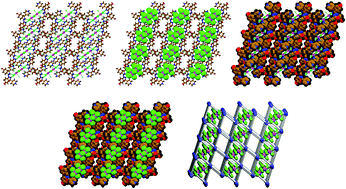Complexes of BiCl3 with hydrazone derived ligands: a Möbius-like discrete metal chelate versus a salt-like porous polymeric structure†
Abstract
In this work we have synthesized and characterized a new helical complex of BiCl3, namely [Bi(LI)Cl3], fabricated with an extremely bulky ligand, 1,2-diphenyl-1,2-bis((phenyl(pyridin-2-yl)methylene)hydrazono)ethane (LI). The same reaction of BiCl3 with N′-(4-hydroxybenzylidene)isonicotinohydrazide (HLII) has allowed us to obtain a salt-like porous polymeric structure ([H2LII]2[BiCl5]·EtOH)n. As evidenced from the single crystal X-ray analysis data, complex [Bi(LI)Cl3] is a Möbius-like discrete metal chelate, where the BiIII atom is seven-coordinated in a distorted pentagonal bipyramidal N4Cl3 geometry and the organic ligand LI adopts a helical twist conformation. The structure of compound ([H2LII]2[BiCl5]·EtOH)n comprises monoprotonated non-coordinated organic molecules [H2LII]+ counterbalanced by a [BiCl5]2− anionic fragment, which, in turn, forms a 1D zig-zag polymeric chain. The organic molecules are arranged in a centrosymmetric fashion yielding a hydrogen bonded tetramer with a rectangular cavity of dimensions 7.55 × 9.02 Å. The tetramers are stacked through weak intermolecular interactions, yielding 1D infinite channels. Thus, complex ([H2LII]2[BiCl5]·EtOH)n was found to be a porous organic–inorganic hybrid compound. By using DFT calculations we have analyzed and rationalized the molecular electrostatic potential (MEP) surfaces and, through the quantum theory of the “atoms-in-molecules” (QTAIM) computational tool, the hydrogen bonding interactions observed in the solid state of both crystal structures, focusing on the competition between O–H⋯O and N–H⋯O hydrogen bonds in ([H2LII]2[BiCl5]·EtOH)n.



 Please wait while we load your content...
Please wait while we load your content...